90 Scabies
90.1 Introduction
7 years 7-year-old male child presents to the outpatient unit with a two-month history of an itchy rash. According to the mother, the rash is recurrent.
- What relevant questions will you ask?
- What is your diagnosis?
- Outline your management plan for this patient
90.2 Definition & incidence/prevalence
It’s a common pruritic skin infection, caused by an infestation of the mite Sarcoptes scabiei var. hominis, which is an obligate parasite. The pruritus associated with scabies is usually severe and more especially at night.
90.3 Epidemiology
It’s a worldwide problem, with a significant public health burden that is, it is very contagious. Prevalence is higher in children and those who are sexually active. Environmental factors that hastens its spread include:
- Overcrowding
- Delayed treatment of primary cases
- Lack of public awareness of the condition
Transmission is by direct contact with infected persons or fomites (beddings, clothing). The crusted scabies (formerly known as the Norwegian scabies) are usually found in immunocompromised and incapacitated individuals.
90.4 Pathogenesis
The incubation period can range from days to months. The whole life cycle of the mite is between 30 to 60 days. It can live approximately 3 days or fewer of the human host but up to 7 days if from crusted scabies. The female mite lays between 1 to 3 eggs a day, which takes approximately 10 days to mature. In first-time infestations, it usually takes 2 to 6 weeks before the host’s immune system becomes sensitized to the mite or its by-products, resulting in pruritus and cutaneous lesions.
90.5 Clinical presentation
Patients will present with symmetrical cutaneous lesions with intense pruritus which is accentuated at night. Cutaneous lesions are usually small erythematous papules with variable degrees of excoriations. Other times, lesions may be vesicular, indurated nodules, eczematous dermatitis and secondary bacterial infections. Burrows, which represent tunnels a female mite excavates while laying eggs are pathognomonic for scabies. Note: The distribution forms the basis of the clinical diagnosis. Areas to look out for lesions include:
- the interdigital webbing of the hands
- flexural aspects of the wrists
- axillae
- posterior auricular area
- waist (including the umbilicus)
- ankles
- feet
- buttocks
- In men, check the penile and scrotum
- In women, the areolae, nipples and vulvar area
- In infants, the elderly and immunocompromised hosts, all skin surfaces are susceptible, including the scalp and face
Figure 90.5, Figure 90.4, Figure 90.1, Figure 90.6 show papules and some excoriations at the typical distribution sites of scabetic lesions (interdigital web spaces, along the phalanges, around umbilicus and wrist). Figure 90.2 shows crusting in the intergluteal cleft, and Figure 90.3 depicts papules and some crusting over the penile glans as well as scabetic granulomas (nodules) on the scrotum of a child.
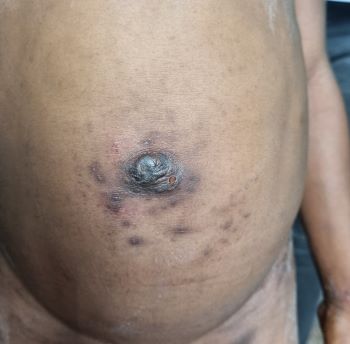
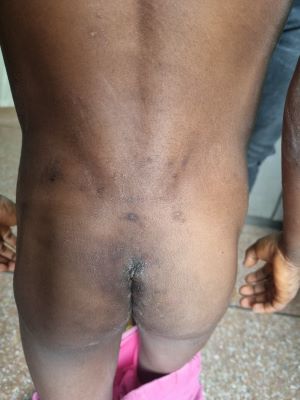
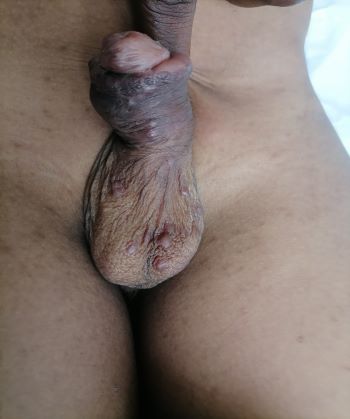

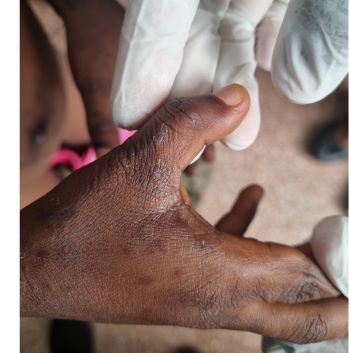
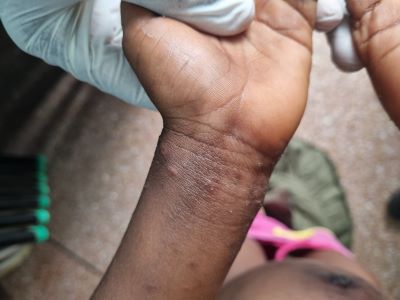
90.6 Investigations
Confirmation of scabies can be done by light microscopy of mineral oil preparation of skin scrapings from an infested area to observe either the mite, its eggs and or scybala (faeces). The skin scrappings can be obtained by using a scalpel blade. Microscopic examination of adhesive tape can also be done. Skin biopsy is rarely performed
90.7 Treatment
Two topical treatments, one week apart of a prescribed anti-scabeitic to be applied from the neck down. Leave on for 24 hours and wash after that. Special attention is to be given to application in the interdigital web spaces, umbilicus, genital and gluteal cleft. Treat all close contacts at the same time. All bedding and clothing are to be washed in hot water, sun dry and ironed to be safe for reuse. Available anti-scabeitics in Ghana are permethrin 5% cream and benzyl benzoate 25%. Oral Ivermectin is reserved for treating crusted scabies
90.8 Complications
They are generally mild, including secondary bacterial infections, a breach in the skin integrity, pain and reduced function due to pain.
90.9 Prognosis
If treated correctly, has a very good prognosis
90.10 Differential diagnosis
In the absence of a burrow and dermoscopically identifying the mite, the differential diagnosis is quite broad including atopic dermatitis, contact dermatitis, seborrhoiec dermatitis, arthropod bites, pyoderma and bullous pemphigoid. In infants, severe infestation can resemble Langerhans cell histiocytosis.